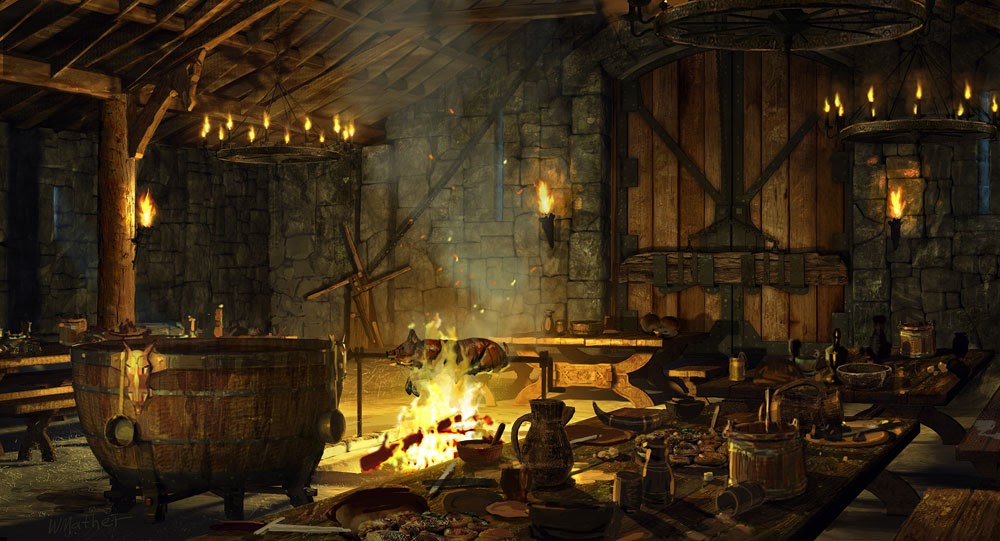In the heart of ancient cultures, meadhalls served as the beating heart of communal life. These grand establishments were not just places to drink; they were vibrant centers of socialization, storytelling, and celebration. The meadhall, often adorned with intricate carvings and warm flames from the hearth, provided a safe haven for warriors, artisans, and families alike, creating a tapestry of shared experiences that forged lasting bonds among their members.
As we delve deeper into the history of meadhalls, we uncover a rich tapestry woven with myths, legends, and communal gatherings. The very essence of a meadhall was to foster a sense of belonging, where tales of bravery and love were exchanged over hearty feasts and cups of honeyed mead. In an era where honor and reputation were paramount, the meadhall became a sanctuary for heroes and a stage for the bards, painting the story of a community's struggles and triumphs.
Today, the meadhall continues to capture the imagination of many, transcending time and becoming a symbol of camaraderie and joy. Whether in literature, film, or modern-day recreations, meadhalls evoke a sense of nostalgia and adventure, inviting us to join in the revelry of ages past. In this article, we will explore the significance of meadhalls, their historical context, and their enduring legacy that resonates in our culture today.
What is a Mead Hall?
A meadhall is more than just a structure; it is a cultural institution. Typically constructed of wood, these halls were often the largest and most important buildings in early medieval communities. They served various purposes, including:
- A gathering place for feasts and celebrations.
- A social hub for storytelling and entertainment.
- A sanctuary for protection in times of conflict.
- A place for governance and decision-making.
What Were the Key Features of Mead Halls?
Meadhalls were designed with specific features that reflected their significance. Here are some key elements:
- Throne or High Seat: Often at the back of the hall, reserved for the lord or chief.
- Long Tables: Typically arranged to accommodate large gatherings.
- Hearth: The central fire where cooking took place and warmth was provided.
- Decorative Elements: Carvings, tapestries, and shields that told stories of valor.
How Did Mead Halls Influence Community Life?
The meadhall shaped the social structure of early societies. Communities would gather to partake in feasts, celebrating victories or marking significant events. The meadhall served as a venue for:
- Festivals: Celebrating the harvest, victories in battle, and seasonal changes.
- Storytelling: Bards reciting tales of gods and heroes, preserving history.
- Conflict Resolution: Gathering to settle disputes and negotiate peace.
What Role Did Mead Play in These Gatherings?
Mead, a fermented beverage made from honey, water, and sometimes fruits or spices, was central to the meadhall experience. It was not just a drink, but a symbol of hospitality and bonding. The act of sharing mead created a sense of unity and goodwill among participants. Mead was often associated with:
- Celebration: Toasting to health, prosperity, and friendship.
- Rituals: Used in ceremonies to honor gods and ancestors.
- Social Status: The quality and quantity of mead served could signify wealth and power.
How Do Mead Halls Appear in Literature and Popular Culture?
Meadhalls have left an indelible mark on literature and storytelling. From the epic tales of Beowulf to modern fantasy novels, meadhalls symbolize camaraderie and adventure. In popular culture, they are often depicted as:
- Gathering Spots: Where heroes meet and legends are born.
- Settings for Conflict: Where rivalries unfold and battles are planned.
- Places of Wisdom: Where elders share knowledge and guidance.
What is the Legacy of Mead Halls Today?
While traditional meadhalls have largely faded from existence, their legacy persists. Modern interpretations can be found in:
- Recreational Venues: Taverns and breweries that capture the spirit of communal drinking.
- Festivals: Events celebrating mead and ancient traditions.
- Literature and Film: Continuing to inspire stories of heroism and friendship.
Conclusion: Why Should We Remember Mead Halls?
Meadhalls were more than mere structures; they were the heart of ancient communities, fostering connections and preserving culture. As we explore their significance, we recognize the importance of gathering, storytelling, and celebration in our lives today. By remembering the meadhall, we honor the traditions of our ancestors and embrace the spirit of togetherness that continues to thrive in modern society.
Article Recommendations
- Jerry Cantrell And His Wife
- Scheels Black Friday 2024
- Who Is The Caveman In Geico Commercials
- Subhashree Sahu All Seasons Mms
- Karoline Leavitt Husband Nick
- Peter Dinklage Son
- Did Jackson White Go To Rehab
- Charly Arnolt Husband
- Hwang In Yeop Kim So Hyun
- George Strait Son Passed Away


